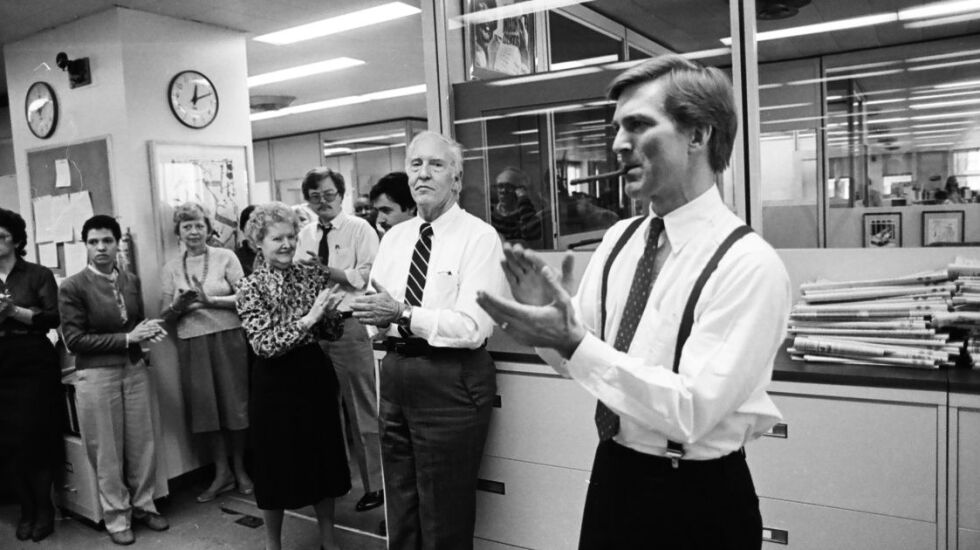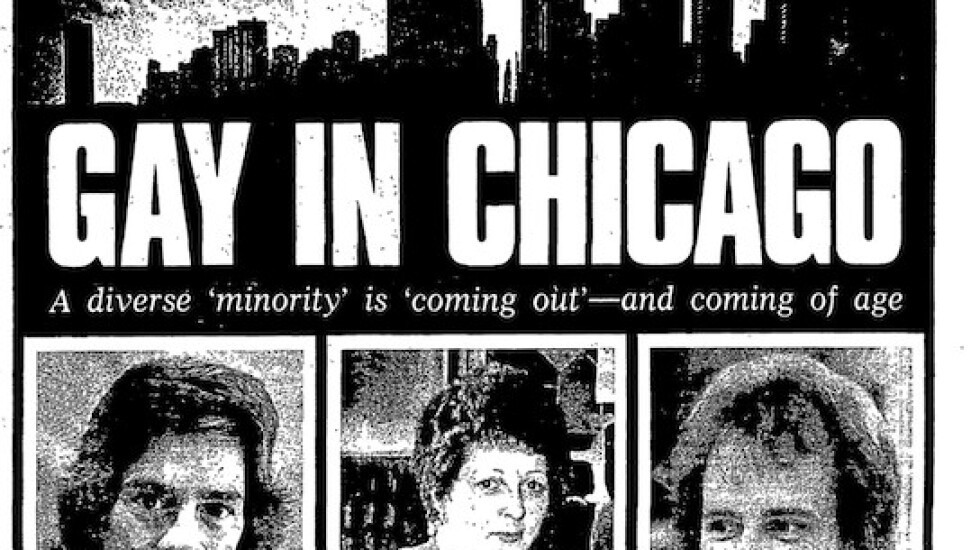
I was battling mixed emotions and anxieties when I was dropped off at the Newberry Library for the Chicago Journalists Association’s award ceremony. Before walking in, I told myself, “If Chicago journalists didn’t know I was gay then, they’ll know now.”
I was a finalist for the Dorothy Storck Award, an honor given to a “highly respected columnist or commentator.” It was a recognition I coveted but thought impossible to get because most past nominees and winners were over 50.
Still, I was determined to celebrate myself and my career. So, in the weeks leading to the event, I bought a sewing machine and loud, hot pink fabric to make a sparkling top with a dramatic, 14-foot cape that could help me stand out in a room full of black suits and dresses.
The night of the awards, my stomach started to ache immediately after I revealed the cape from under my winter coat. I was becoming more and more convinced my outfit was an inconvenience to carry around a crowded cocktail party and not exactly the Met Gala fantasy I was aiming for. It didn’t help that someone was unawarely standing on my cape.
I wondered whether my outfit was a showcase of unapologetic pride or an embarrassing shame.
The answer came to me when Tracy Baim — a queer Chicago journalism icon who was being honored with a lifetime achievement award — made her way to me with a look of awe on her face. She praised my outfit, calmed my anxiety and said that, given the challenges gay people faced in mainstream newspapers for years, it was a joy to see me like this.
I visited Baim last month to dig deeper into the significance of that moment and learn about LGBTQ+ journalism history and the Chicago trailblazers who came before me.
Baim said she couldn’t help but channel people like Randy Shilts, a white, cisgender man who fought an uphill battle being an openly gay journalist at a mainstream outlet like the San Francisco Chronicle in the 1980s, and others who were not able to be out in their mainstream jobs or were forced out of the closet.
“There were many cases of people fighting discrimination, either privately or in public, and you’re the culmination of that,” Baim told me. “You and many other of your peers [telling people] that the closet was not ever going to hold you back. It was never going to hold me back, either.”
Baim’s parents worked for the Chicago Tribune. When she moved back to Chicago from college, she didn’t have rose-colored glasses about gay representation at mainstream newspapers.
She said even in the early 1980s (and decades prior) — reporters and editors — whether straight or closeted — were afraid to know too much about the gay community. Having proximity to gayness or any kind of association with a gay person could raise eyebrows and accusations like, “You know a lot about the gay people. You must be gay, too.”

One of the first publicly gay journalists at a Chicago mainstream paper
John Teets, a gay journalist, joined the newspaper in 1966. But his sexual orientation wasn’t immediately known. It took a few years before, as he described it, he was “kicked out of the closet.”
Teets, now 74, worked as a clerk in the wire room, a caption writer, photo editor, copy editor, news editor and eventually joined the Sun-Times editorial board. Throughout the mid-1960s and 1970s, he had girlfriends and even an office romance with a woman.
After that relationship ended, he found love in 1976 with a man who loved parties and wanted to attend a work-related party Teets was invited to. To please his lover — the couple is still happily married today — Teets had to be brave.
“I had a plus-one and was suppose to tell the managing editor, Ralph Otwell, who my date was. So I walk in to his office and said, ‘Ralph, I will indeed bring someone to the party.’ And he said, ‘What’s her name?’ I said, ‘Robert.’ He clamped down on his pipe for a minute, and then he said, ‘I look forward to meeting him.’ And he turned to his typewriter and got back to work.”

Through other occasions that mixed work with his personal life, the staff at the Sun-Times eventually knew Teets was gay. He said he was lucky to have that kind of work atmosphere.
Other closeted reporters from Chicago Tribune took note and called him to a secret meeting in Rogers Park.
“They didn’t want to be anywhere near downtown,” Teets said. “And I think there were probably a dozen of totally closeted gay folks quizzing me on how one could be gay and work for a newspaper. I could do it. Randy Shilts could do it in San Francisco. How could you be gay and work for a newspaper? Well, you love newspapers. That’s how you do it.”
Sun-Times gay series in the mid 70s and campaigning on human rights
Another monumental moment Teets had during his time as an editorial writer at the Sun-Times was contributing to a week-long series in the mid-1970s titled “Gay in Chicago: A diverse ‘minority’ is ‘coming out’ — and coming of age.”
He said the suggestion for the series came from Sun-Times religion writer Roy Larson, who was a former minister. Reporter Pat Anstead also contributed to the series.
“It was an uncovered topic. Nobody had done this sort of thing. And that was back when the New York Times wouldn’t even print the word gay,” Teets said.

The three spent two weeks reporting on gay people in the church, gay and lesbian nightlife, at-risk and homeless youth, lawyers and business owners. The purpose of the series was to educate the public on the diversity in gay culture, and how people experienced and dealt with immense discrimination.
Teets said there was mixed reaction from readers. I was curious and asked Teets if the other board members were resistant or pushed back in publishing editorials about gay issues during his time on the board almost 50 years ago.
No, he said.
“When you campaign on human rights, you campaign in all of them,” he added.
HIV’s influence, straight reporters on the gay beat
Initially in the 1980s, AIDS-phobia had the public and the media categorizing people as innocent victims or guilty victims — people who got AIDS through faulty blood transfusions vs. gay men who got AIDS through sex, for example.
But as more people were diagnosed with AIDS, news outlets were challenged to change how they framed gay news. AIDS also forced many in the media out of the closet, people who had HIV or had friends who did.
Baim said that, as a result, media outlets were forced to provide better coverage. Some of the young journalists leading the way were Sun-Times medical reporter Howard Wolinsky and investigative reporter Tom Brune.
Wolinsky started working at the Sun-Times in March 1981 but had been on the health beat covering AIDS since it was first known as GRID, or Gay Related Immune Deficiency.
Wolinsky would cover AIDS from a medical point of view. Brune covered it from a societal point of view.

In 1987, Wolinsky and Brune — who are both straight — were presented with the Friend of the Community Award by Gay Chicago magazine.
“We felt the coverage Wolinsky and Brune provided finally broke down many of the stereotypes people have about the gay community,” Dan Di Leo, co-publisher of Gay Chicago, said in a Sun-Times report on the award.
I asked Wolinsky whether he ever felt shame or anxiety about people judging him for reporting on gay news in the 1980s. He said he never thought about that.
“As a reporter, I feel like I’ve been informed by my readers,” Wolinsky said. “And, you know, I’ve made mistakes. But I learned to see things from a different way and adjusted language used in my coverage.”
Gay people in Chicago media today
On the awards night last fall, Baim was recognized for her achievements and I ended up winning first place for the columnist award at 30 years old, the first Latino and openly gay person to do so.
My cape got stuck on chairs as I made my way to the podium, but I didn’t care. Baim and others were there supporting me on a night I now see was years in the making.







